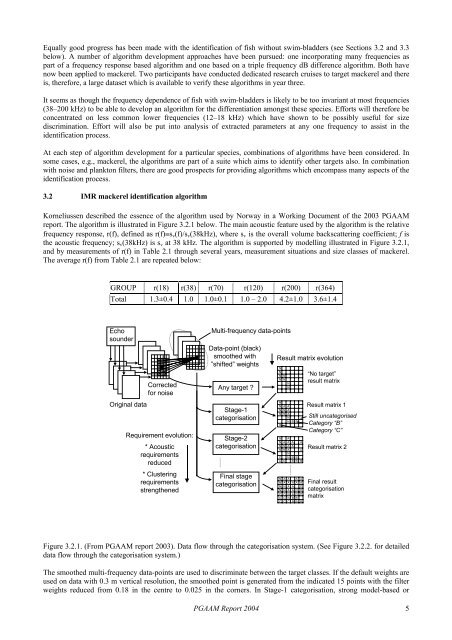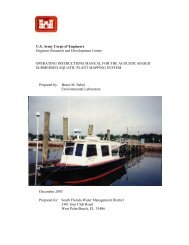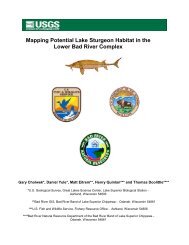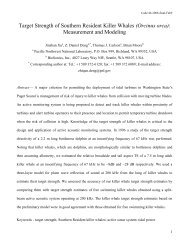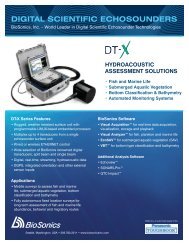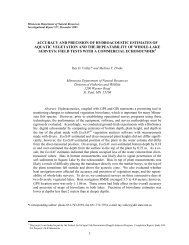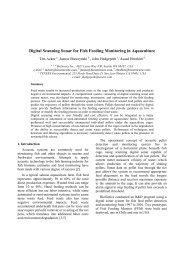Aerial and Acoustic Surveys for Mackerel - BioSonics, Inc
Aerial and Acoustic Surveys for Mackerel - BioSonics, Inc
Aerial and Acoustic Surveys for Mackerel - BioSonics, Inc
You also want an ePaper? Increase the reach of your titles
YUMPU automatically turns print PDFs into web optimized ePapers that Google loves.
Equally good progress has been made with the identification of fish without swim-bladders (see Sections 3.2 <strong>and</strong> 3.3<br />
below). A number of algorithm development approaches have been pursued: one incorporating many frequencies as<br />
part of a frequency response based algorithm <strong>and</strong> one based on a triple frequency dB difference algorithm. Both have<br />
now been applied to mackerel. Two participants have conducted dedicated research cruises to target mackerel <strong>and</strong> there<br />
is, there<strong>for</strong>e, a large dataset which is available to verify these algorithms in year three.<br />
It seems as though the frequency dependence of fish with swim-bladders is likely to be too invariant at most frequencies<br />
(38–200 kHz) to be able to develop an algorithm <strong>for</strong> the differentiation amongst these species. Ef<strong>for</strong>ts will there<strong>for</strong>e be<br />
concentrated on less common lower frequencies (12–18 kHz) which have shown to be possibly useful <strong>for</strong> size<br />
discrimination. Ef<strong>for</strong>t will also be put into analysis of extracted parameters at any one frequency to assist in the<br />
identification process.<br />
At each step of algorithm development <strong>for</strong> a particular species, combinations of algorithms have been considered. In<br />
some cases, e.g., mackerel, the algorithms are part of a suite which aims to identify other targets also. In combination<br />
with noise <strong>and</strong> plankton filters, there are good prospects <strong>for</strong> providing algorithms which encompass many aspects of the<br />
identification process.<br />
3.2 IMR mackerel identification algorithm<br />
Korneliussen described the essence of the algorithm used by Norway in a Working Document of the 2003 PGAAM<br />
report. The algorithm is illustrated in Figure 3.2.1 below. The main acoustic feature used by the algorithm is the relative<br />
frequency response, r(f), defined as r(f)≡s v (f)/s v (38kHz), where s v is the overall volume backscattering coefficient; f is<br />
the acoustic frequency; s v (38kHz) is s v at 38 kHz. The algorithm is supported by modelling illustrated in Figure 3.2.1,<br />
<strong>and</strong> by measurements of r(f) in Table 2.1 through several years, measurement situations <strong>and</strong> size classes of mackerel.<br />
The average r(f) from Table 2.1 are repeated below:<br />
GROUP r(18) r(38) r(70) r(120) r(200) r(364)<br />
Total 1.3±0.4 1.0 1.0±0.1 1.0 – 2.0 4.2±1.0 3.6±1.4<br />
Echo<br />
sounder<br />
Original data<br />
Corrected<br />
<strong>for</strong> noise<br />
Requirement evolution:<br />
* <strong>Acoustic</strong><br />
requirements<br />
reduced<br />
* Clustering<br />
requirements<br />
strengthened<br />
Multi-frequency data-points<br />
Data-point (black)<br />
smoothed with<br />
”shifted” weights<br />
Any target ?<br />
Stage-1<br />
categorisation<br />
Stage-2<br />
categorisation<br />
Final stage<br />
categorisation<br />
Result matrix evolution<br />
N<br />
N<br />
N<br />
N<br />
N<br />
N<br />
N<br />
N<br />
C<br />
N<br />
N<br />
N<br />
N<br />
C<br />
C<br />
N<br />
N<br />
N<br />
N<br />
C<br />
C<br />
C<br />
N<br />
N<br />
A<br />
N<br />
N<br />
A<br />
N<br />
N<br />
C<br />
A<br />
A<br />
N<br />
N<br />
C<br />
C<br />
C<br />
N<br />
N<br />
A<br />
A<br />
A<br />
N<br />
N<br />
A<br />
A<br />
A<br />
A<br />
N<br />
N<br />
A<br />
A<br />
A<br />
A<br />
N<br />
N<br />
C<br />
B<br />
A<br />
A<br />
B<br />
B<br />
A<br />
A<br />
A<br />
A<br />
B<br />
B<br />
B<br />
B<br />
B<br />
A<br />
A<br />
D<br />
D<br />
B<br />
B<br />
A<br />
D<br />
B<br />
A<br />
A<br />
D<br />
D<br />
D<br />
B<br />
“No target”<br />
result matrix<br />
Result matrix 1<br />
Still uncategorised<br />
Category “B”<br />
Category “C”<br />
Result matrix 2<br />
Final result<br />
categorisation<br />
matrix<br />
Figure 3.2.1. (From PGAAM report 2003). Data flow through the categorisation system. (See Figure 3.2.2. <strong>for</strong> detailed<br />
data flow through the categorisation system.)<br />
The smoothed multi-frequency data-points are used to discriminate between the target classes. If the default weights are<br />
used on data with 0.3 m vertical resolution, the smoothed point is generated from the indicated 15 points with the filter<br />
weights reduced from 0.18 in the centre to 0.025 in the corners. In Stage-1 categorisation, strong model-based or<br />
PGAAM Report 2004 5


